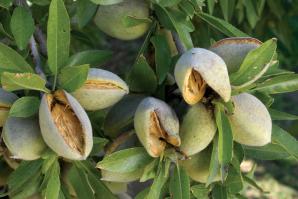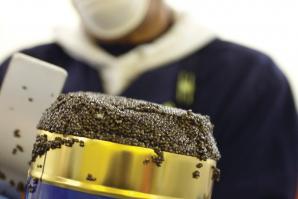For Capital Region farmers looking to expand sales overseas, Gov. Arnold Schwarzenegger’s recent trade mission to Asia couldn’t have come at a better time. While any governor’s visit would likely attract attention, it helps to have an international film star as a spokesperson.
Local producers have their fair share of challenges and obstacles — both foreign and domestic — in selling products outside the U.S. But being California-grown comes with its own set of advantages that poise growers, co-ops and dairies throughout the state, and particularly in the vast growing regions of the Central Valley, to compete successfully on the international stage.
According to the governor’s office, California is the No. 1 exporting state in the U.S. for agriculture, a substantial percentage of which comes from the Central Valley. Good trade relations are vital to California’s economy.
According to Jay Van Rein from the California Department of Food and Agriculture, the state’s agricultural exports were valued at a whopping $12.9 billion in 2009, and the USDA estimates that for every $1 billion in exports, 8,000 jobs are generated.
What’s more, every million-dollar increase in exports supports 11 jobs, according to the U.S. Department of Commerce.
As the Central Valley, including San Joaquin County, grapples with devastating unemployment numbers — as high as 40 percent in some areas — the importance of expanding trade opportunities in Asia could generate much needed employment in areas hit hardest by the recession.
Japan, China and South Korea represent California’s third-, fourth- and fifth-largest trading partners, respectively. Statewide agricultural imports to those three countries alone totaled $3.5 billion last year with the top exports including almonds, dairy, wine and rice.
Even with those high numbers, however, California could be doing better.
“There is a lot of room to grow in those markets in Asia,” says Andrea McCarthy, deputy press secretary for the governor. “Opening additional access to these markets for California’s agricultural products was a top priority of the trade mission as part of an overall effort to create more jobs and grow California’s economy.”
Gov. Schwarzenegger may not have come home with a slew of new trade agreements in hand, but history suggests these trade missions yield meaningful long-term results. For example, the governor’s trade mission to China in 2005 resulted in special waivers to allow the import of California strawberries for the 2008 Olympics in Beijing. Another was the trade mission to Mexico in 2006, which helped pave the way for lifting a ban on California-grown spinach in 2007.
Pushing Congress to approve the U.S.-Korea Free Trade Agreement was a hallmark of this year’s mission. California is the No. 1 state for imports to South Korea. The agreement could increase California’s agricultural exports to South Korea by as much as 50 percent, representing hundreds of millions of dollars and thousands of jobs.
High-profile trade missions are only one part of a much broader marketing mix for growers. Regardless of the specific product, the challenges they face both in terms of competition from other growers and growing regions, as well as bureaucratic obstacles, are significant.
For starters, producers and distributors must ensure potential customers know their products exist.
“Simple awareness of California products and the diversity of products we have to offer is a significant barrier to more trade,” says Josh Eddy, trade specialist with the state Department of Food and Agriculture. “It literally takes events like the governor walking into a market in Japan and showing off California products to create that awareness.”
Next, the challenges tied to costs are a problem. It’s not uncommon for imported California products to have a price 20 to 25 percent higher than competitive products that have been produced domestically or imported from closer regions.
“California is a high-cost producer; that’s just a fact of life,” says Kirk Messick, senior vice president with the Farmer’s Rice Cooperative in Sacramento, which exported nearly 165,000 tons of milled rice last year at a value of about $160 million. “Regulatory standards for pesticide, herbicide and water use are increasingly hampering cost effectiveness. Whereas our international competitors are simply lower-cost producers.”
By the same token, it’s what the government is not doing that also hampers trade. The free-trade agreement with South Korea, for example, was signed in June 2007 but has yet to be ratified by Congress.
Since that time, South Korea has executed a free-trade agreement with the European Union and is close to another with Canada. Trade Partnership Worldwide LLC, an international trade and consulting firm based in Washington, estimates that failure to approve the agreement could cost $2.5 billion on goods exported from California and the loss of nearly 40,000 jobs.
State and federal government actions aside, the logistics of getting a product from California to markets in Europe or Asia come with financial ripples, as do labor costs for harvesting and packaging. Earlier this year, Schwarzenegger vetoed legislation that would have given farm workers the same rights to overtime pay that other hourly workers receive, primarily because of the long hours required to harvest crops quickly and get them to market. It’s likely similar legislation will be introduced when a new governor takes office in January, and industry estimates predict payroll costs for agricultural producers would increase at least 10 percent if it passes.
It’s not uncommon for imported California products to have a price 20 to 25 percent higher than competitive products that have been produced domestically or imported from closer regions.
Tariffs and other requirements imposed by foreign governments are another major challenge.
“There are two primary obstacles we have to overcome. The first being legitimate quarantine issues addressing pest issues that exist here and are not known to occur in the importing country,” says Frank Carl, Sacramento County’s agricultural commissioner. “The second is the artificial quarantine requirements that are intended to reduce volume of exports but have little to do with real pest risk.”
As commissioner, Carl’s office is charged with issuing federal phytosanitary certificates, which indicate the product to be exported has been inspected and found compliant with standards established by the importing country. His office issues about 4,000 certificates annually with an office of fewer than 30 workers — and it’s at risk of shrinking.
“Our biggest concern is being able to meet the demands of shippers in a timely manner,” Carl says. “We have recently lost 28 percent of our staffing through layoffs or attrition. Six of those were licensed to issue certificates.”
All said, local producers have still been able to turn some of these more pressing challenges into a competitive advantage. For one, all those regulations about pesticides and fertilizers translate into high food standards that help create demand for California products.
According to Messick, package-labeling laws in most overseas and developing markets have been very loose, and as a result consumers have become wary of products blended with a certain percentage of inferior ingredients.
“Our main message to the overseas consumer is ‘100 percent pure California,’” Messick says. “Many overseas consumers view U.S. products, and particularly California products, as the highest in both food quality and food safety. In most cases, the fact that our packaging promotes our product as pure California offsets our higher cost disadvantage. Most Arab countries, for example, will pay a 20 to 25 percent premium for our rice over that from other countries because they want to be assured their food is safe.”
The weather has also lent Capital Region producers a hand. The milder climates make for longer, more frequent and more bountiful growing seasons, enabling growers to meet demands in overseas markets when competitors simply have no product to offer.
For instance, California’s main competitors in the rice market are Australia, Egypt and China, all of which are low-cost producers that have been forced to reduce or stop rice exports. Australia is enduring a drought that is now in its seventh year, China has experienced shrinking grain stocks as a result of increasing population and standards of living and Egypt has banned rice exports altogether because of concerns over water availability from the Nile River.
The circumstances have all presented huge opportunities for the state.
For other producers, simple diligence has paid off.
This year marks the 100th anniversary of Blue Diamond Growers, headquartered in Sacramento. As it observes this milestone, it has much to celebrate. Each year, some 3,000 growers deliver almonds to the cooperative, which exports them to 90 countries. The industry is estimated to have produced 1.65 billion pounds of almonds this year. That’s up 9 percent from last year, and of which 70 percent will be exported at a price of about $2 billion.
That makes almonds California’s largest food export and the sixth-largest U.S. food export.
Last year alone, exports of California almonds grew in every major market; 12 percent in Europe, 22 percent in Asia-Pacific and 10 percent in the Middle East and Africa.
The organization has worked since the 1940s to expand access to foreign markets. It also has a history of creating demand for its products and keeping them affordable, while building and maintaining a reputation for quality. For example, almost right from the beginning the company began linking nutritional value to almonds and advocated them to consumers. Of course, any other almond producer could do the same.
“What sets us apart as our competitive edge is our size and product innovation leadership,” says John O’Shaughnessy, general manger of Blue Diamond’s Consumer Products Division. “Our competitors simply do not have enough of the best nuts, and therefore their quality is spotty. We are the industry leader in innovation in terms of offering new ways to enjoy almond nutrition.”
Recommended For You

Tough Nut to Crack
Almonds bust then boom in China
Richard Waycott says there are no silver bullets in the remarkable double-digit growth of California almond exports to China but rather a carefully honed strategy built on introducing almonds to a “pre-existing snacking culture.”

Feast or Farmin’
Sac aqua farms produce 85 percent of the world's white sturgeon caviar
Inside a concrete warehouse a few miles past Sacramento International Airport, an 80-pound white sturgeon is hauled onto a table, sliced throat to tail and relieved of its egg-stuffed ovaries. Workers at Sterling Caviar LLC pack the meat on ice, ship the roe elsewhere and repeat the process.



